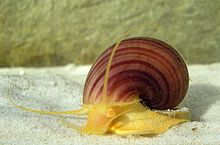- Pomacea bridgesii
-
Pomacea bridgesii 
Pomacea bridgesii in aquarium Conservation status NE[1]Scientific classification Kingdom: Animalia Phylum: Mollusca Class: Gastropoda (unranked): clade Caenogastropoda
informal group Architaenioglossa
Superfamily: Ampullarioidea Family: Ampullariidae Genus: Pomacea Subgenus: Pomacea Species: P. bridgesii Binomial name Pomacea bridgesii
(Reeve, 1856)- See also: Pomacea diffusa, formerly known as Pomacea bridgesii.
Pomacea bridgesii, common names the Spike-topped apple snail or Mystery snail, is a South American species of freshwater snail with gills and an operculum, an aquatic gastropod mollusk in the family Ampullariidae.
Contents
Subspecies
- Pomacea bridgesii bridgesii (Reeve, 1856)
- Pomacea bridgesii diffusa (Blume, 1957)
Anatomy
Mystery snails possess structurally complex eyes at the tip of a cephalic eyestalk. These snails possess the ability to regenerate the eye completely after amputation through the mid-eyestalk. They are born with both gills and lungs. [2]
Distribution
The native distribution of this snail is Bolivia, Brazil, Paraguay and Peru.
Non-indigenous distribution
It is non-indigenous in Hawaii since 1960 (Pomacea bridgesii diffusa), south-east Asia since 1980s and in Florida since early 1980s (Pomacea bridgesii diffusa).[3]Blakoo
Offspring
Mystery snails lay their eggs above the water line, which take 2-4 weeks to hatch. They can have as many as two-hundred offspring.
Human relevance
It is often kept as an aquarium pet because of its wide range of shell colors, lack of appetite for live plants, and ease of care.
References
- ^ 2007 IUCN Red List of Threatened Species. <www.iucnredlist.org>. Cited 14 April 2008.
- ^ Bover, M. M. (1988). "Eye regeneration in the mystery snail". J. Exp. Zool. 245 (1): 33–42. PMID 3351443.
- ^ Pomacea bridgesi
External links
Categories:
Wikimedia Foundation. 2010.
